#pelagic thresher
Explore tagged Tumblr posts
Text

(Please click for quality it looks so crusty)
🎶 Teenage mutant ninja SHARKIES 🎶
Heroes with the fish tails, sharky power!
MASTERPOST
(Individuals pics and yapping under the cut ^^)
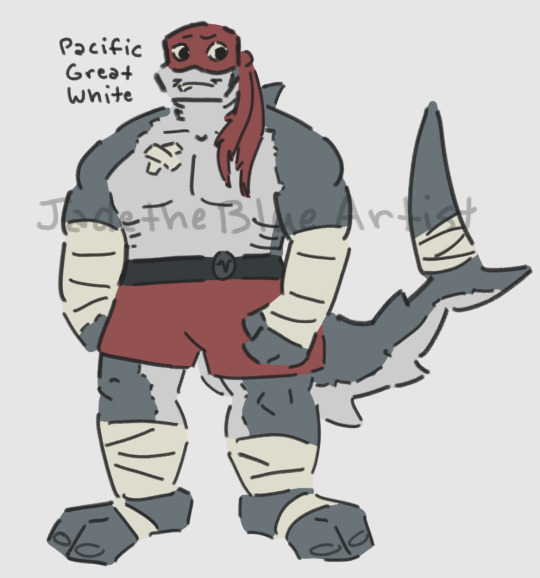

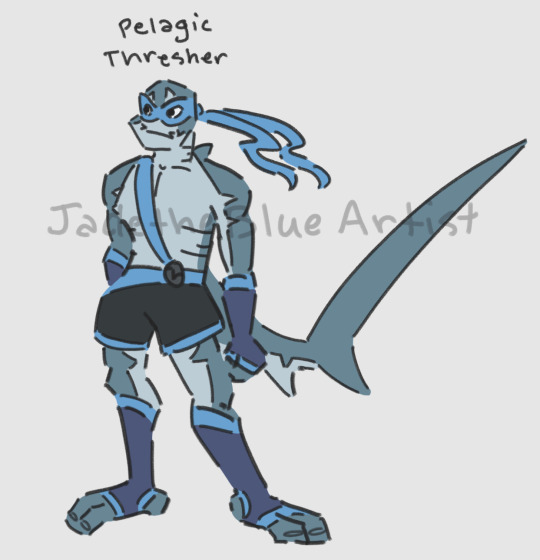
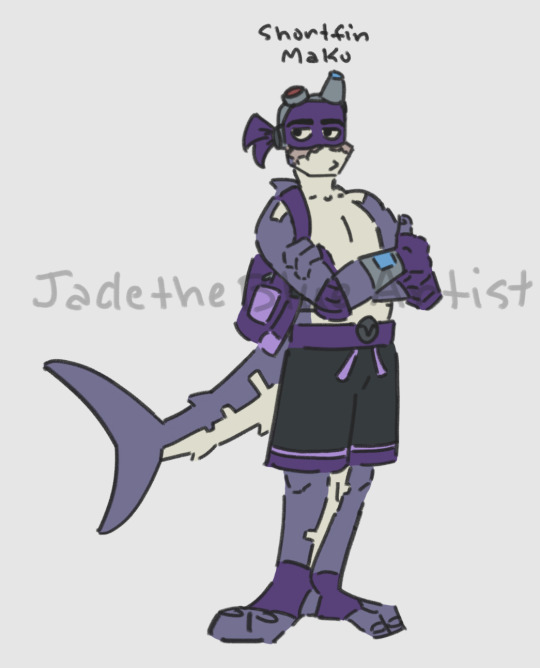
HEHE THE HYPERFIXATION CONTINUES this took my several hours bc i draw so slowly and dont realize it so that was great but i really like them ^^
Raph is a great white just bc I thought it fit, Mike is a leopard shark bc of spots and bc little, Leo is a pelagic thresher bc he’s a speedy boy, and Donnie is a shortfin mako bc they’re very smart!
I was trying to find an equivalent to sharks for Donnie and his soft shell but i couldn’t think of a species specific thing so I’ve decided that when they were rescued my Lou, he got burn damage to his snout where his sensing organs are and since sharks rely on that organ a lot due to they’re poor eyesight, he can struggle in seeing things. Technically they all have awful eyesight but the others can sense the electro magnetic fields and whatever so they’re good. Hence Don needs glasses and just still struggles beyond that.
Ummmmm yeah so they all have tails and dorsal fins and little fins on their tails. They each have sets of gills on their necks and rib area while also having lungs. They can breathe underwater then, they just have to keep their mouths closed. I also think their lair situation would be the same with more pools for them since they do like water but their human characteristics don’t make them dependent. Maybe just water lovers and avid moisturizers.
OKAY IF ANYONE WANTS TO SEND ME AN ASK ABOUT THIS ID BE HAPPY TO TALK BUT YOU KNOW UP TO YOU TEEHEEHEEHEE I NEED TO EAT NOW BYEEEEEEE
#rottmnt#rise of the teenage mutant ninja turtles#rise of the tmnt#tmnt#save rottmnt#riseofthetmnt#save rise of the teenage mutant ninja turtles#save rise of the turtles#rottmnt raph#rise raph#rottmnt mikey#rise mikey#rottmnt leo#rise leo#rottmnt donnie#rise donnie#teenage mutant ninja sharkies#rottmnt au#rise au#sharks#rottmnt sharks#great white shark#leopard shark#pelagic thresher#thresher shark#shortfin mako shark#jadethebluearts#teehee now I wanna do the rest of the family#tho idk how different they’d be…. the possibilities
842 notes
·
View notes
Text
ok so like many people on here i'm very autistic abt fish (and other animals) so i'm gonna just start posting my notes app infodumps on the fish autism website
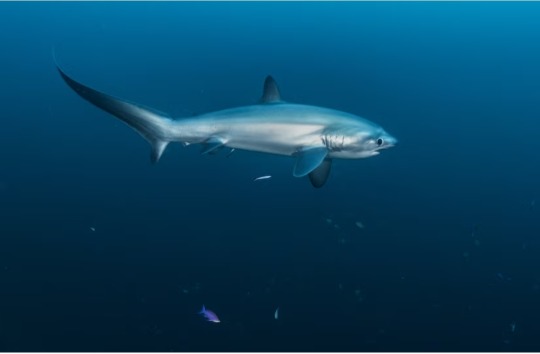
Definitely one of the goofiest sharks out there, i've gone on record as claiming the pelagic thresher (Alopias pelagicus) as my favorite shark. Threshers are known for their extremely long tail, which is used to help catch prey. The thresher uses its tail like a whip to stun groups of small fish. Points for creativity!
The pelagic thresher can be identified by dark patches of skin around the base of its fins and smaller eyes than its relatives. Perosnally, I would describe the species as looking like its mom just left it in line at the cash register to go grab something she forgot. Delightful lil guys!
Sources/further reading:
https://www.nationalgeographic.com/animals/fish/facts/pelagic-thresher
#i've gone back and forth on whether or not to post my infodumps like these for a while#hope ya like em#im making a tag for them#el's infodumps#my names el btw (shortening of my irl name)#pelagic thresher#thresher#shark#thresher shark
67 notes
·
View notes
Text

thresher sharks are some of the cutest sharks in existence to me
made in 2024
#thresher shark#pelagic thresher shark#shark art#fish art#printmaker#printmaking#linocut print#linoprint#linocut#block printing#block print#traditional printmaking#traditional printing#traditional art#small artist#artists on tumblr#lesbian artist#butch artist#trans artist#disabled artist#marine biology#linocarving#original art#linogravure#nature art#animal art#sea creature art#sea creatures#art#fishblr
246 notes
·
View notes
Note
Ooh ooh any kind of thresher shark? Your style is so fun I love this concept,,,

fish 343 - pelagic thresher shark
help out palestine
234 notes
·
View notes
Text
its official. pelagic thresher sharks are the most absurd little miserable creechures i have ever seen

i love it
3K notes
·
View notes
Text
Fish of the Day
Today's fish of the day is the the Pelagic thresher shark!

The pelagic thresher, also known as the pacific common thresher shark, scientific name Alopias pelagicus, is a common thresher shark. Found along the tropical and subtropical waters in the Pacific and Indian ocean, stretching from South Africa to The West Coast of America. Like other thresher sharks, the pelagic thresher inhabits the open ocean, occasionally coming close to the continental shelf near coral reefs, and seamounts. Seasonally, they migrate North and South, to follow warmer waters. Pelagic threshers are the smallest species of thresher shark, and despite being visually similar to their relatives they can be differentiated by the dark pigment above the pectoral fins and the rounded fin tips.Similar to other threshers, the teeth are smooth and small, with 20-22 teeth per jaw, curved inward to trap prey inside their mouth.

Due to their medium size, the pelagic thresher is predated on by many larger predators. Primarily larger sharks, orcas, and other toothed whales that share an area. They are known to have tapeworm parasites and copepods in the skin. This leads to the symbiotic relationship with cleaner wrasses, who eat their parasites. The pelagic thresher's diet consists of small prey along the mesopelagic zone, primarily lightfishes, barracudas, flying fishes, herrings, squids, and mackerels. This keeps them from competing with other oceanic predators in their size range, such as tuna, billfish, and other sharks. They hunt similar to other thrasher sharks, by swimming tight circles around a school of prey, until they condense. Then, striking with the upper caudal fin tip lobe of the tail to stun. This long tail is often the cause for plegic threshers getting hooked as bycatch for other fishing efforts, specifically having issues with longlines. Although several commercial fisheries go out of their way to hunt for plegic threshers, leading to their status as endangered.

Just like all other mackerel sharks, the pelagic thresher shark is ovoviviparous, meaning they have young kept in eggs within the mother, and when they hatch, they are born live. Similar to other thresher sharks , the pelagic thresher gives birth to two pups at a time, one per each uterus. They have no defined breeding season and the gestation period is unknown, but assumed to be similar to the year gestation period of common threshers. Pups are born surprisingly large, at about 5 feet in length. As compared to the sexually mature adult size of about 10 feet, the largest recorded being around 11feet. Maturity is reached at around 9 feet in length, which is usually around the 8th or 9th year in females, and around 7-8 years in males. Their lifespan is about 28 years in females, possibly longer, whereas male threshers get the short stick, living only 17 years in comparison.

Have a wonderful day, everyone!
#fish#fish of the day#fishblr#fishposting#aquatic biology#marine biology#animal facts#animal#animals#fishes#informative#education#aquatic#aquatic life#nature#river#ocean#shark#sharks#thresher shark#pelagic thresher shark#pacific thresher shark#pacific common thresher shark#Alopias pelagicus
72 notes
·
View notes
Text
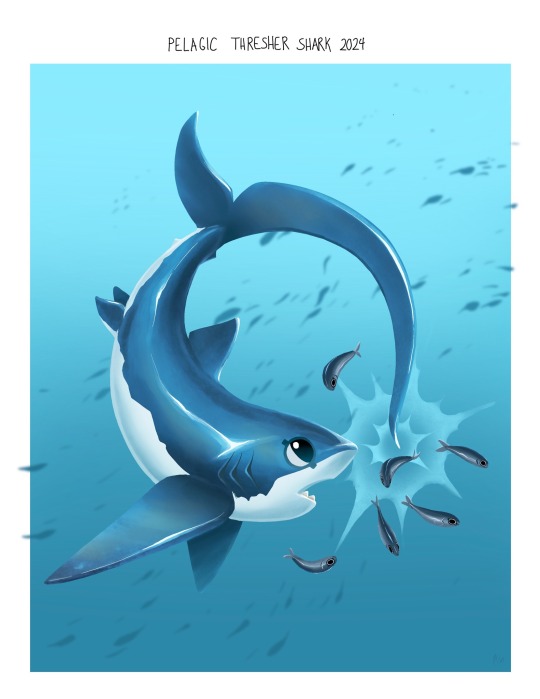
Thresher Shark! Specifically a Pelagic thresher in this painting but there are three species of Thresher. Each has a very elongated part of their tail which can be used to stun prey to eat.
#art#digital art#digital#illustration#shark#shark week#procreate#ipad pro#ipad art#thresher shark#pelagic thresher shark
12 notes
·
View notes
Text
#shark#shark facts#song in bg is cat hacks by lemon demon#made in capcut#sharks in order of appearance:#whale shark#pelagic thresher shark#wobbegong shark#lemon shark#leopard shark#whitetip reef shark#nurse shark#hammerhead shark#blacktip reef shark#port jackson shark#blue shark#manta ray#frilled shark#zebra shark#oceanic whitetip shark#megamouth shark#mako shark#cant identify#bull shark#basking shark#holy shit thatd a lot of tags 💀#one more for good luck 🤭
54 notes
·
View notes
Text
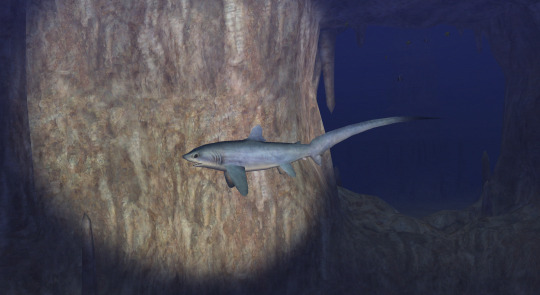
Thresher Shark - Great Aqua Cave
Endless Ocean, Nintendo Wii
I LOVE YOU GREAT AQUA CAVEEEE, and i love you pelagic thresher too!
#endless ocean#endless ocean 1#endlessocean#endlessoceanphotos#nintendo wii#wii#pelagic thresher shark#great aqua cave
13 notes
·
View notes
Note
Bro they do even cooler hunting where they approach some prey angled slightly downwards, bring their pectoral fins (the ones which are like shark arms) forward to stop their momentum, but their tail still keeps its momentum and it flips over the shark's head and cracks like a whip into some fish, which is literally fucking sick.


Have you done any fun facts about thresher sharks? Love ur blog!!! :3
Ahh that makes me so happy!! This blog is still really new and I was mostly just expecting it to be me talking to myself, so it makes me smile to know you like it too :)
I haven't had a chance to talk about thresher sharks yet, but aren't they great? All three species of threshers are just peak sharks, really - they're cool, they got big silly eyes, they always look like they just nervously asked you to prom and weren't expecting you to say yes and now they don't know what to do
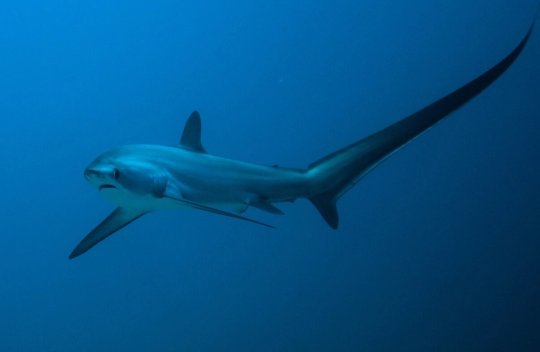
How about some fun facts about the pelagic thresher? They're actually the smallest of the three thresher species (not that any of them are super big, really), and it's easy enough to confuse them with the common Atlantic thresher that we actually can't be confident we know what their range looks like! Their big eyes are a hallmark of the species (they make them look so cute and silly), and they actually decrease in size relative to the shark's body with age, so you can guesstimate a thresher's age as juveniles will have very big peepers. We can't be certain at this stage, but current research indicates that, unlike the common thresher, the pelagic thresher probably isn't warm-blooded, which has interesting implications for how even sharks within the same genus have evolved to thermoregulate differently.
Of course, one of the coolest things about pelagic threshers is their hunting strategies! These sharks literally evolved to herd fish around and then slap them with those long tails.

114 notes
·
View notes
Text
I keep seeing these cute “guess the shark species” slideshows l on tiktok, but they always show a pelagic thresher shark and just call it a “thresher shark,” so I realized not a lot of people might know there are three species of thresher shark. I’m going to introduce you to all of them and give you some certified marine biologist (tm) tips and tricks to notice species-specific features to look for once you see the long tail that indicates it’s in Alopiidae (since even google images messes it up sometimes).
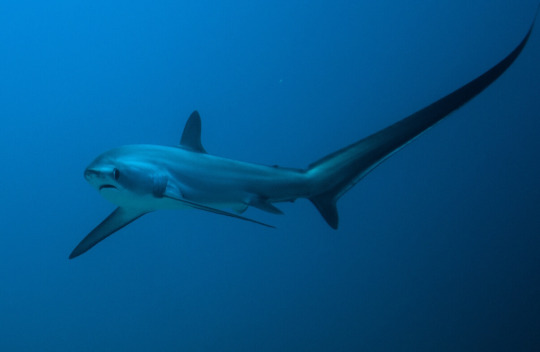
This is a pelagic thresher shark (Alopias pelagicus). It is the smallest of the three species, and usually the one everyone thinks of. Some of the most distinguishing features to me are the slender body shape, a smooth head with no noticeable ridge, and eyes that are still somewhat large, but not noticeably so. But the most important distinguisher to me is its coloration, the white on the shark’s ventral side forms a border with the grey on it’s dorsal side, and this border goes *under* the pectoral fins, not *over*. They can be found to at least 150 m.
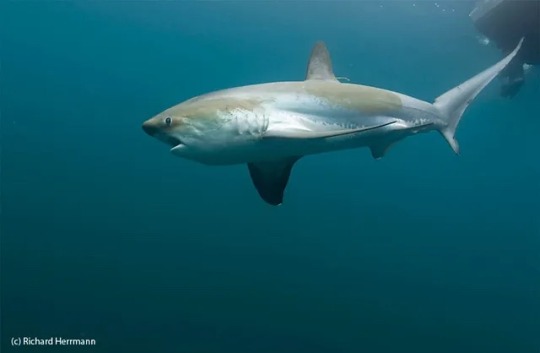
The common thresher shark (Alopias vulpinus) is the one that’s the most annoying to find on google images, because half the images are of the pelagic thresher. It is the largest species of thresher shark. As you can clearly see, these guys are a bit chunkier and also don’t have a noticeably large eye, and they have a smooth head that lacks a noticeable ridge. But the most important distinguisher for these guys is also related to their coloring. As you can kind of see in this photo, the border between the white of the ventral side and grey of the dorsal side goes well above the pectoral fin, so they have a spot of white that goes *above* their fin. This is the easiest way to distinguish them from pelagic thresher sharks, since you might see them within the same size range, so going off of body shape and size alone isn’t the most reliable.

And lastly, we have the bigeye thresher shark (Alopias superciliosus), so hopefully now it’s clear why I was harping on the eyes so much for the last two. Their gigantic uwu eyes are definitely a distinguishing feature, but the most prominent feature you want to look for during identification is the large ridge between the top of their head and their body. It’s super noticeable in person as well, and is not a feature shared by the other two sharks. These are the most easily distinguishable from the other two, and can be found to a depth of up to 723 m.
All thresher sharks are ovoviparous, so they give live birth! And they’re all cutie patooties who deserve to be appreciated.
#marine biology#thresher sharks#thresher shark#deep sea#sharks#shark facts#marine bio#woooo shawks :3#wittle guy#wittle baby
756 notes
·
View notes
Text
Okay I finally got everything decided for the merfolk Straw Hats! I’ll be tagging everything related to this as ‘merfolk au’.
Luffy is a bull shark. Hear me out on this one. This shark is a voracious eater and an extremely strong predator. They’re also capable of surviving in freshwater for surprisingly long periods of time, which I think compliments Luffy’s adventurous nature. They also sometimes fight crocodiles, which I just happened to find funny.
For Zoro, I think the green moray eel would be fitting. I know swordfish is the obvious choice, but I wanted to do something different. These fish are aggressive and vicious fighters. Also, they don’t clean themselves and instead rely on other fish to clean them, which is very Zoro like in my humble opinion.
Nami is a flame angelfish. A gorgeous fish that is known for having a temper. They’re also expensive in the fishkeeping hobby, which is very on brand for Nami.
Usopp is an indo-pacific sailfish. Between them being one of the fastest fish in the ocean and their long nose, it’s a perfect fit.
Sanji is a pelagic thresher shark, a fierce fighter that uses its tail as its main weapon. They’re also very athletic, capable of swimming at high speeds and breeching out of the water.
Chopper is a reindeer that ate the mer-mer fruit and became a blue spotted pufferfish merman. I chose this one because the defense mechanism fits his scaredy cat personality, and also because this fish doesn’t get along with members of its own species very well.
Robin is a mimic octopus. They can change colors, as well as alter the length and texture of their legs, which I think works well with her devil fruit ability. They’re also masters at hiding which suits her well.
Franky is a peacock mantis shrimp. These guys are very intelligent, and their strong armor and unique attacks suit Franky’s cyborg status nicely. Their colorful appearance and blue head is also fitting to such a colorful and boisterous character.
#one piece#monkey d luffy#luffy#zoro roronoa#nami#cat burglar nami#usopp#sanji#black leg sanji#tony tony chopper#nico robin#merfolk au#i made my favorite character my favorite fish lol#but i think it fits!#cyborg franky#franky the cyborg
195 notes
·
View notes
Text
“A RAPID AND POWERFUL VENTRO-DORSAL PEDUNCULAR MOTION DROVE ITS TAIL FROM ITS BASE IN A TREBUCHET CATAPULT MOTION THAT TERMINATED OVERHEAD IN A SLAP” 🗣️ 🗣️🔥
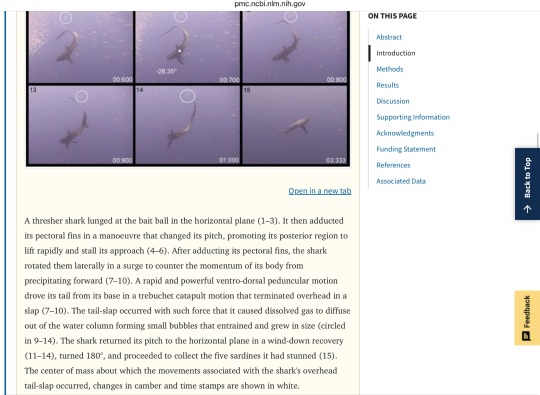
source: https://pmc.ncbi.nlm.nih.gov/articles/PMC3707734/ (Thresher Sharks Use Tail-Slaps as a Hunting Strategy)
#marine biology#aquatic animals#fish#wildlife#biology#ecology#funny fish#cartilaginous fish#sharks#i love sharks#shark#ichthyology#elasmobranch#marine animal#marine life#marine fish#biophysics#biomechanics#thresher shark
7 notes
·
View notes
Text
SHARK FACT!
Newborn pelagic thresher sharks, Alopias pelagicus, can be as long as almost half the length of the mother. Most of this is down to those tails which can account for 50% of the total length of the shark, but it's still long.
There are three currently described extant thresher shark species (Alopias spp.), smallest is the pelagic thresher A. pelagicus, the bigeye thresher A. superciliosus is in the middle size wise, and the common thresher A. vulpinus are the largest. All three are ovoviviparous, which means that although the babies develop in eggs, these eggs are never layed and the sharks give birth to live young.
10 notes
·
View notes
Note
can I have facts on my favourite shark (thresher) and my second favourite (lesser white)
i can give you shark facts any day my friend!
for thresher shark, my fav fact is that their tail makes up about 50% of their body length... boy why you so tail! but also threshers arent one species of shark they are three! (well three extant ones, there are around 13 identified extinct species) there is the pelagic thresher (Alopias pelagicus), the bigeye thresher (Alopias superciliosus) and the common thresher (Alopias vulpinus) and speaking of tails, the big upper lobe allows them to swim really fast (though they dont make it into the top 5 fastest sharks) and even cooler is they use the tail as a weapon to stun prey! their closest relatives are the families Cetorhinidae (which only contains one extant species, the basking shark, which is both the 2nd biggest shark species and the second biggest fish species) and Lamnidae (which contains the white shark, the two mako shark species, the porbeagle shark and the salmon shark)
as for lesser white shark, ive actually never heard that name before and when i google it i mostly just get arguments over the naming of the white shark (Carcharodon carcharias) which is known to the general public as the great white shark, but is just called the white shark by shark scientists because the great in the name is involved in shark fearmongering and implies that there is a "lesser" white shark which is incorrect as the white shark is the only surviving species of its genus. the other species that come up under that name is Hubbells white shark (Carcharodon hubbelli) which is extinct and the oceanic whitetip shark (Carcharhinus longmanus). this confusion over names is the exact reason why binomial nomenclature exists, there can be a lot of overlap between common names, from regional differences in what people call one species or different species being called the same thing. my fav example of this is the sandfish, which is both a name for a number of different fish species as well as a lizard species
anyways im assuming you mean the oceanic whitetip (not to be confused with the whitetip reef shark (Triaenodon obesus) or the whitetip weasel shark (Paragaleus leucolomatus)), since that species is both extant and the most simular to the white shark in behaviour and habitat out of the ones coming up. the oceanic whitetip is of the family Carcharhinidae, which is the largest shark family, with 60 identified members, and is also my personal favourite family. this family also contains the bull shark (Carcharhinus leucas), the lemon shark (Negaprion brevirostris) and my personal favourite babygirl, the blacktip reef shark (Carcharhinus melanopterus). despite being such a big family, there is surprisingly little known on their phylogenic relationships with each other besides being split into 11 genera, with over half of the species, including the oceanic whitetip, all being in the same genus. the oceanic whitetip is easily identifyable, not just because of the white tips to the fins, but also because they have unusually large fins which are very rounded, unlike most shark species whos fins are pointed. theyre a solitary species when it comes to other sharks, but they can often be found surrounded by remoras, pilot fish and other species that have mutualistic relationships with sharks. pilot fish specifically like to hang around oceanic whitetips though this is not exclusive. and of course i have to mention my fav fact about them which is theyre known colloquially as "sea dogs" because they have been known to follow ships around and have a reputation for eating shipwreck survivors! theyre one of the only shark species known to actively eat humans (most sharks take one bite and realise that theyre not food and leave) because theyre opportunists and not one to be picky
11 notes
·
View notes
Note
any facts about thresher sharks? They look really neat!
Well:
The thresher sharks' most distinguishable feature, its whip-like tail, is mainly used for hunting. Also known as caudal fins, these tails measure half the length of their body and are used to stun and herd prey. With a flick of their tails, thresher sharks can create shock waves that immobilize schools of fish - their favourite dish - making them easier to catch.
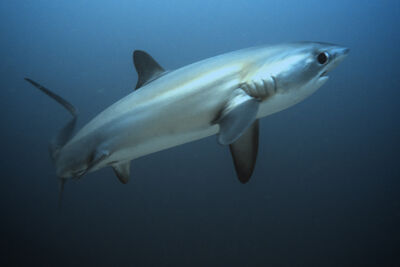
The thresher shark reigns as one of the fastest predators in the ocean, reaching impressive speeds of up to 22 miles per hour. Comparatively, great white sharks reach 15 mph, while nurse sharks cruise at a leisurely two mph. Their competitive edge comes from their extra-long trail and torpedo-shaped body, which helps them dart through the water

While thresher sharks are primarily pelagic, they breed in coastal waters. Juvenile thresher sharks will stick to these shallower, safer waters until they reach maturity, after which they will migrate to the deeper open ocean. Threshers will spend most of their lives at around 550 metres, but have been recorded reaching depths of 1,500 metres, making them one of the ocean's deepest dwellers
One of the most spectacular behaviours of thresher sharks is their ability to breach the water's surface. They use their powerful tails to propel themselves out of the water, reaching heights of up to three metres. The reason behind this behaviour is still not entirely understood, but it's believed to be related to communication, parasite removal or just for fun

39 notes
·
View notes